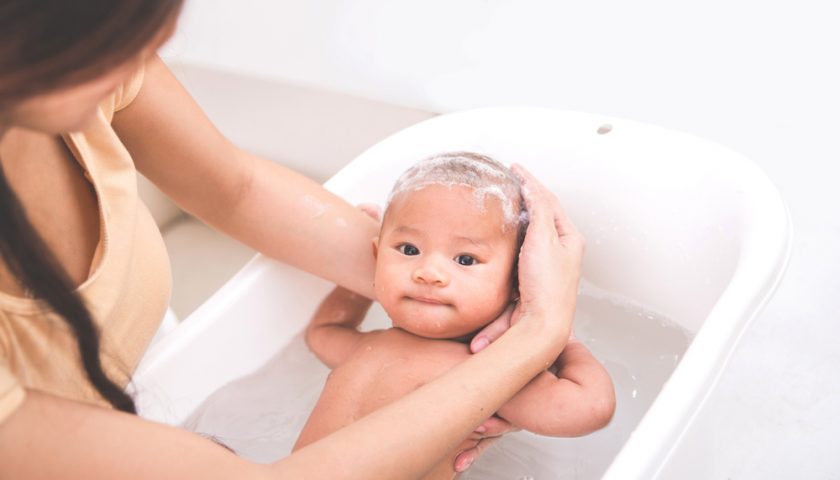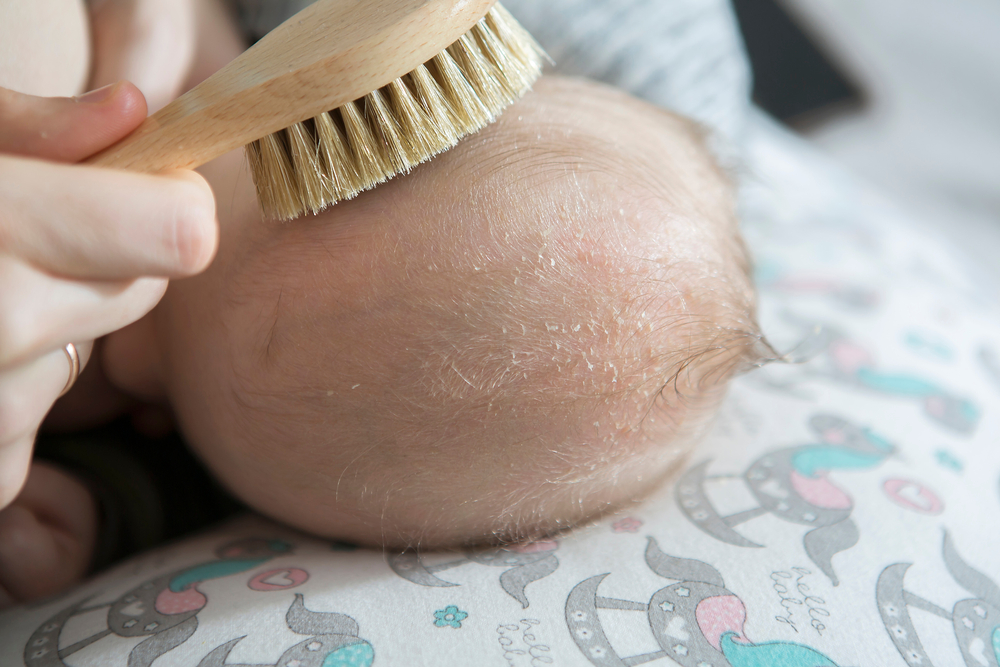Cradle cap gets its name from the fact that it affects very young babies, therefore ‘cradle’. But also ‘cap’, because a cradle cap can resemble a thick, waxy, sometimes yellow layer covering the scalp’s skin, similar to a cap.
Baby cradle cap appears to be not harmful for the infants. It simply does not appear to be attractive.
You can do some home remedies to get rid of the cradle cap in toddlers that simply involve washing and cleaning the scalp.
Let’s see what is a cradle cap and remedies to treat it.
Table of Contents
What is a Cradle Cap?
Cradle cap, commonly known as crib cap, is a type of seborrheic dermatitis that affects babies. In adults, seborrheic dermatitis causes dandruff. On the other hand, it causes excessively thick and flaky skin on the scalp of newborns.
Cradle cap is a frequent condition that is largely harmless and will ultimately disappear. It’s most frequent in babies under the age of three months, but it might persist a year or longer. Cradle cap usually goes away before a child’s first birthday, and cases continue to decline as he or she approaches the age of four.
It affects the head and can be concentrated behind the ears. It can also affect the skin beneath the brows, on the nose, armpits, and groyne. The flakes are typically white or yellow and might be dry or oily.
Cradle cap is completely innocuous, and removing it is not medically essential. However, there are a few safe procedures you can apply at home to try to remove it.
Cradle Cap Home Remedies for Babies
The following are some effective home remedies for cradle cap in small newborns that you can try at home.
Brush Scalp of Your Baby
Brushing your baby’s scalp gently might help lift flakes off their head, but avoid picking or scraping at the flakes.
To employ this treatment:
- Brush the afflicted area of the scalp in one direction to dislodge flakes.
- Brush through hair again to eliminate flakes from each thread. This can be done with wet or dry hair.
Brush the baby hair once a day. Brush less frequently if the scalp feels red or irritated.
Hydrate the Scalp
Hydrating the scalp loosens flakes and nourishes the scalp underneath. A pure plant oil, such as olive, coconut oil, or almond oil, is required. Baby oil is also effective.
How to apply this technique?
- Apply a small coating of oil to the scalp.
- Massage the oil gently for about a minute. Use extra caution near this area if your infant still has a soft spot on their head.
- Allow 15 minutes for the oil to absorb.
- Use a gentle baby wash to remove the oil.
You can use this approach once a day. This strategy appears to be beneficial anecdotally, but there is no study to back it up.

Wash Hair of Baby
Baby cradle caps can be reduced in appearance by maintaining proper hair hygiene. Cradle cap can sometimes be treated with just baby shampoo.
Shampooing is a great way to get rid of cradle cap flakes temporarily, and it’s also very safe if you use baby shampoo. Simply avoid getting soap in your baby’s eyes.
Tip: You could also brush your baby’s hair while shampooing.
Inquire with your paediatrician about how often you should wash your baby’s hair. Shampooing too often might dry out the scalp and aggravate the baby cradle cap. To consult with the best paediatricians near you, you can visit the Healthwire.pk.
Try Kitchen Remedies for Baby Cradle, if OK’d by Your Paediatrician
You can also look for some kitchen ingredients to get rid of the cradle cap of your baby. However, make sure to get an approval from your doctor, if it’s ok or not.
Here are some home remedies for cradle caps using simple home kitchen ingredients.
Coconut Oil
Coconut oil has long been used to treat tiny bruises as an antifungal and antibacterial agent. It is highly efficient in treating infections caused by cradle cap in newborns.
How to use it?
- Warm a few drops of coconut oil in your hand by rubbing it between your palms.
- Apply the oil to the affected areas of the baby and gently massage it in.
- Allow for a 20-minute rest period before brushing away any flakes of scalp tissue that may have become dislodged during the massage.
- Wash off the oil with lukewarm water and shampoo after twenty minutes.
Vaseline
Vaseline or any refined petroleum jelly helps to keep the skin moisturised and prevents it from drying out. It also aids in the removal of dead skin from the scalp.
How to use it?
You can apply a teaspoon of vaseline to your baby’s scalp and leave it on overnight. Wash it with water the next day and use a mild shampoo to remove the jelly.
Olive Oil
Olive oil, which includes vitamin E, is one of the healthiest oils for the skin. Olive oil’s vitamin E nourishes and protects the skin from infections. It is one of the most effective natural treatments for infant cradle caps.
How to use it for cradle cap treatment?
Apply a couple teaspoons of olive oil to the scalp and gently massage it in. To get a nourished scalp, let it on for a few hours or even overnight before rinsing it off with a light shampoo.
Get to know more about olive oil benefits.
Shea Butter
Shea butter, which is widely available, is an excellent moisturiser that also soothes irritated skin.
How to use it?
Apply a large amount of shea butter on the baby’s scalp. Allow it to work on your scalp, then gently scrape away the flaky layer with a soft brush. The cream can be gently wiped away with a clean cloth or washed away with water.
Aloe Vera Gel, Of course!
Aloe Vera has a cooling impact on the body and is found in a variety of medical remedies for skin problems. Aloe vera gel can be made from fresh plant cuttings and processed to apply to the head. It should be used with caution on babies due to its cooling effect. To reduce inflammation, leave the gel on for a few minutes.
Read further about the health benefits of aloe vera.
When to Seek Help?
Cradle cap is normally not a life-threatening condition, but it’s worth reporting to your doctor at your child’s check-up.
Call your doctor if skin on the baby scalp appears to be particularly red, infected, or irritated. If the cradle cap spreads over the baby’s face or torso, you should also contact a doctor.
Outlook!
Cradle cap is normally innocuous and goes away on its own. It usually fades away by the baby’s first birthday, while some children may have it until they are between the ages of 2 and 4. You can attempt some safe cradle cap removal procedures at home, but always use caution when handling products and infant skin.
